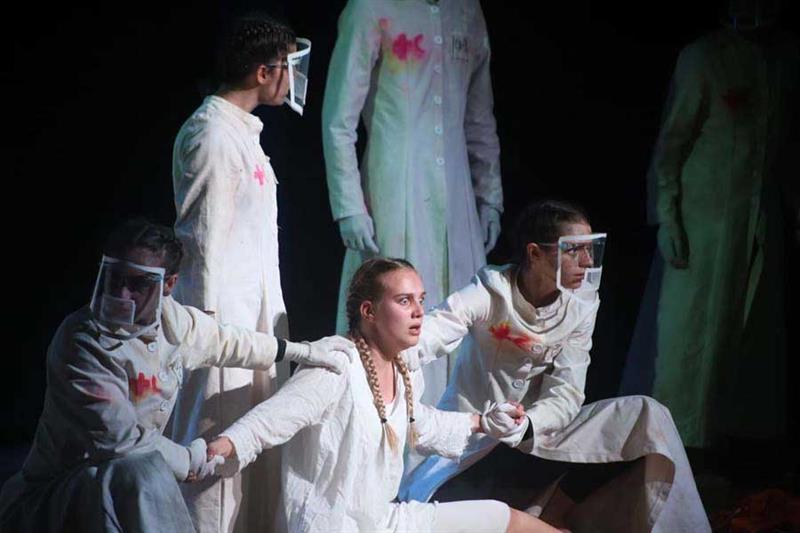
Sharm El Sheikh Int’l Theatre Festival for Youth opens with Italian play’s quest to save humanity
Directed by Fabio Omodei and performed by nine young actors — six women and three men — from the Theatre Academy in Rome, ‘The Last Flowers’ interlaces mise-en-scene with large segments of physical expressions and choreography that aim at depicting a variety of emotions as well as eras that the viewers are taken into.
In this dynamic presentation, the protagonist Sofia (played by Sofia Morabito), is perplexed in the world dominated by pandemic which, as we learn throughout the play, took toll on the world leaving only nine people, eight of whom represent beliefs completely opposite to that of the main character. However, the play is not about Covid-19 per se, rather it sheds light on an unknown disease that is an excuse to touch on today’s reality led by technology and medical advancements, and lack thereof, on the account of emotional life aspects and human hearts.
For the eight characters named Beta 2, Beta 3, Beta 4, etc, science is the solution to the world pains; it is an option that could save the humanity: the only valid path of rescue. Sofia however looks for happiness or rather a human heart, persisting against all odds that she can find it through different tools: emotions and peace. While all the Betas focus on replacing infected parts of the body with technological advancements and mechanical prosthesis – as they hope to do with the heart – Sofia searches for love to play a role in the healing process that would eventually restore the world’s perfection. Indeed, can a human heart find its perfect prosthesis?
In her dreams, hallucinations or maybe through her recurring coma – as this is left to the viewers’ interpretation – Sofia visits distant cultures. She rotates the small world globe in her hands and is taken onto a time – rather than geographical – trip to different historical events. In Sofia’s journey, the characters form one theatrical fabric, one ideology, which surrounds her as she tries to oppose them, shifting between the 20th century wars and even further back, to the conflicts of Ancient civilizations.
She finally finds her joy in the most distant times, those inhabited by monkeys. She finds out that in their world the word ‘peace’ is not even comprehended by the characters, since conflict, wars or human disasters, do not exist either. It is there that she finds the seeds of humanity, possibly among the extinct forms of human species, prior to the advanced homo sapiens.
The play relies a lot on the group scenes, performed by the eight characters abundant in choreography and change of simple costumes. An over 1.5 hour long play uses a lot of straight forward symbolism which makes the performance accessible to all cultures and ages. In this context, the work is a perfect material for international travels and its participation in festival targeting young audience and adult viewers will be always welcome.
The images compensate the minimal language that is used by the actors. At the same time, the light approach to the subject matter topped with a few spoons of comedy, definitely diffuses the serious issues presented by the performers and makes the play even more enjoyable.
It is however the duration of ‘The Last Flowers’ that creates a fog over its interesting core values, since they are well read within the first half an hour of the play. The core concept is then repeated extensively on the stage, while a few anti-climax theatrical procedures give a false sense of multiple conclusive endings to the performance.
In her role, Sofia Morabito gives a whole range of colors to the protagonist, showcasing confusion, anger, desperation, fear, but also joy, hope, carefree spontaneity and never ending enthusiasm. Had the group scenes, or ‘the morbid fabric’ presented by eight actors been more rehearsed and perfected, they would have given the play a truly shining character.
A reminder of importance of humanity, human heart and emotions is definitely well needed in today’s world, especially as we are about to emerge from the long months of Covid-19 pandemic. Equally, the return of theatre activities across many stages, alongside of reinvigoration of festivals such as Sharm El Sheikh International Theatre Festival for Youth, is a hope that revival of theatre, arts and human life in general is actually taking place in front of our eyes. It is for the creative minds to continue stepping in with valuable artistic work.
The competitive segment of the festival includes a total of six plays in its Main Competition, four plays in Monodrama Competition and four plays in a competition named Street Performances and Plays in Non-Traditional Spaces. The plays have been chosen from 302 submissions from local, regional, and international troupes.
In its 6th edition launched on 6 November, the Sharm El Sheikh International Theatre Festival for Youth is yet to present over 15 plays from numerous countries, as well as hold seminars and workshops.
The festival continues until 11 November 2021.
Held annually, the SITFY is the first of its kind to be organized in Sinai. It was launched with the aim of providing opportunities to young theatre practitioners while decentralizing the artistic scene and reviving tourism in South Sinai.
The SITFY’s founder and president is Mazen El-Gharabawy, and the artistic director is Ingy El-Bastawi.
Tags:Festival, sharm, theatre, youth
Post Discussion